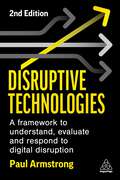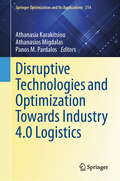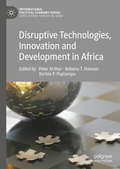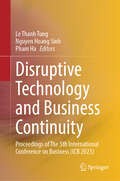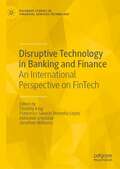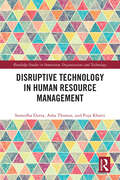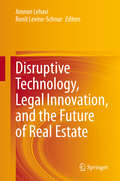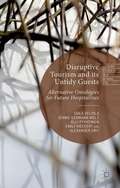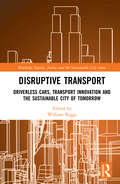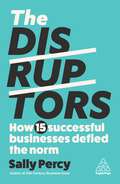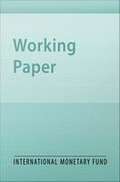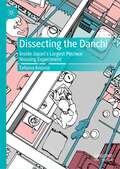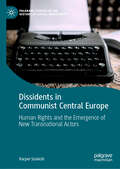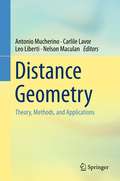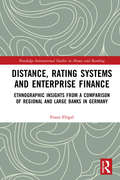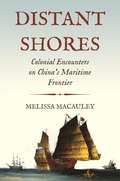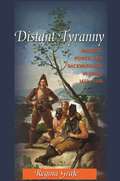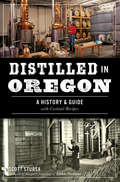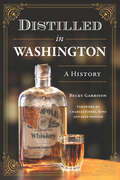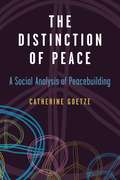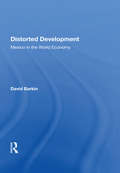- Table View
- List View
Disruptive Technologies: A Framework to Understand, Evaluate and Respond to Digital Disruption
by Paul ArmstrongThe next two decades will see more waves of technological disruption than the previous fifty. Adaptability and understanding of technological changes are now mission-critical to every business.Disruptive Technologies offers a three-step framework that enables readers to choose how their business responds to technological upheaval rather than being led by changes forced upon them. Showing how to understand a new technology, evaluate the challenge it poses, and finally respond to it, readers will come away secure in the knowledge that they have a workable system with which they can navigate ongoing technological disruption. This second edition features new chapters on the Metaverse and Web 3.0, as well as case studies and discussions of emerging technologies such as NFTs, artificial intelligence, virtual and augmented reality, graphene and 3D/4D printing.If companies do not grasp how developing technologies will impact their operations, supply chains, people and products, they have little hope of weathering the ongoing storm of digital disruption. Disruptive Technologies is your essential guide to creating a stable response to constant technological upheaval.
Disruptive Technologies and Optimization Towards Industry 4.0 Logistics (Springer Optimization and Its Applications #214)
by Panos M. Pardalos Athanasia Karakitsiou Athanasios MigdalasThis contributed volume guides researchers and practitioners on resource collaborative management of supply chains and manufacturing enterprises within an industrial internet technological environment. The book comprises 10 chapters that cover two major topics in the subject of logistics 4.0, namely the utilization of both disruptive technologies and optimization techniques in smart logistic management. With global research on the book's topic expanding rapidly across various directions and disciplines, it provides a structured framework for international experts to showcase outstanding work and unique approaches. Researchers and students will find the comprehensive outline on collaborative optimization and management of smart manufacturing and production, warehousing, inventory, logistics, transportation, integrated supply chain, and supply network within the industrial internet platform a beneficial guide to understanding current and future practical problems that arise in manufacturing and supply chain management.
Disruptive Technologies, Innovation and Development in Africa (International Political Economy Series)
by Peter Arthur Kobena T. Hanson Korbla P. PuplampuThis book examines how disruptive technologies and innovation underpin the attainment of a broader development agenda in Africa. Contributors show how distinctive forms of technological innovation can impact critical development processes. For example, disruptive technologies can deepen the ongoing democratic and governance waves in Africa, specifically in the area of contested elections. Similarly, innovations in agriculture, the environment and energy promote changes in value chain agriculture, and the use of sensors to manage e-waste and sustainable energy conservation are also transforming established practices. Furthermore, the role of disruptive technologies and innovation in education, health, financial services and the nature of paid work cannot be ignored. Individually and collectively, the authors discuss and highlight the mechanisms and initiatives that can contribute to the realization of the development goals of African countries, especially in a period where disruptive technologies are rapidly changing how things are done. As a result, this book, which represents one of the most recent systematic efforts to bring together dialogue on disruptive technologies in Africa, will be of particular use and benefit to a wide and an eclectic audience.
Disruptive Technology a Heartbeat Away: Ecton, Inc.
by Edward G. Cape Clayton M. ChristensenDescribes an innovating start-up company with a disruptive technology to the large, expensive echocardiography machines that leading cardiologists use to create images of heart functions for diagnostic purposes. Ecton's machine is small, cheap, portable, and can't create images as clear as those that large, expensive instruments can make. The entrepreneur is searching for a market for his product, and wonders whether he should sell out or try to build a successful commercial organization.
Disruptive Technology and Business Continuity: Proceedings of The 5th International Conference on Business (ICB 2023)
by Le Thanh Tung Nguyen Hoang Sinh Pham HaThis book offers an up-to-date and comprehensive picture of the Vietnamese economy, which is the fast-growing economy in Southeast Asia. The country has invested heavily in education, health, and development infrastructure across the country. Progress in recent decades has been strong and Vietnam has attracted significant relocation and outsourcing of production from The Organization for Economic Cooperation and Development (OECD) countries. In the recent years, much of the foreign direct investment from China has been channeled to Vietnam. The state’s development policy has created optimal conditions for further expansion of production, supply chain, education and finances. Investment in education, health, infrastructure, administration and regulations is facilitating investment inflows, technology transfer and spillover to the growing national companies. The educated young population and disciplined labor force have provided a strong basis for the growth of the economy. The high level of productivity, improved quality of products, low and competitive cost of production, and over 100 million people provide a strong base for a continuous economic growth. This edited volume, brings together selected papers presented at The 5th International Conference on Business (ICB 2023), providing good insights into the features of the economy and its development potential. They provide an up-to-date overview and an empirical research-based picture of the recent trends in Vietnam's economic development. The book would be a useful read for educators, undergraduate and graduate students, domestic and foreign investors, government agencies, provincial and industrial sector decision-makers, trade partners, libraries, individual researchers, and professional and practitioners. It helps to fill the gap in knowledge and inform development planners and investors about different sectors of the Vietnamese economy and its development potential.
Disruptive Technology in Banking and Finance: An International Perspective on FinTech (Palgrave Studies in Financial Services Technology)
by Jonathan Williams Timothy King Francesco Saverio Stentella Lopes Abhishek SrivastavThis book exemplifies the potential of FinTech to deliver important economic and societal gains, such as enhancing competition and financial inclusion to deliver tailored financial products and services at more affordable prices and at greater convenience. The emergence of FinTech directly challenges the business models of incumbent financial intermediaries like banks, which are adapting by developing their own FinTech offerings and partnering with FinTech and large technology firms. FinTech also constitutes both known and unknown risks to financial stability and challenges regulators to evaluate whether existing regulations are sufficient. The emergence of FinTech as a global phenomenon requires insightful cross-country analysis and different perspectives to evaluate its development and associated opportunities and challenges. This book will be of interest to practitioners, regulators and students of this essential enabling technology that is a major component of the Fourth Industrial Revolution.
Disruptive Technology in Human Resource Management (Routledge Studies in Innovation, Organizations and Technology)
by Sumedha Dutta Asha Thomas Puja KhatriTechnological breakthroughs obliterate established methods and change entire industries. Disruptive technologies are seen as drivers of various business processes, and one area that these technologies have had a profound impact on is human resource management (HRM). The applications of disruptive technology in the field of HRM represent an ever-intriguing domain for researchers and professionals. These technologies have altered the processes of acquitting, hiring, training, and managing employees. The book Disruptive Technology in Human Resource Management is an attempt to lucidly explain the significant makeover introduced by a few significant disruptive HRM technologies - artificial intelligence, blockchain, big data/data analytics, robotics, cloud computing, digital transformation, and social media. It examines how disruptive technologies have impacted the evolution of numerous HR practices, including but not limited to recruitment, selection, orientation, training, employee welfare, performance evaluation, pay structure, and job design.Corporate examples help highlight the manner in which the amalgamation of disruptive technology with HRM has increased the strategic relevance of HRM. The book provides tools, tactics, and perspective to innovate, push oneself, excite others, and establish a world-changing disruptive business model. This real-world book provides concise insights into how disruptive technology open doors to in-cash multifold HRM opportunities.Combining theory with practice, this volume will be of value to scholars and upper-level students across HRM, and technology and innovation management.
Disruptive Technology, Legal Innovation, and the Future of Real Estate
by Amnon Lehavi Ronit Levine-SchnurThis book addresses challenges that new technologies and the big data revolution pose to existing regulatory and legal frameworks. The volume discusses issues such as blockchain and its implications for property transactions and taxes, three (or four) dimensional title registration, land use and urban planning in the age of big data, and the future of property rights in light of these changes. The book brings together an interdisciplinary collection of chapters that revolve around the potential influence of disruptive technologies on existing legal norms and the future development of real estate markets. The book is divided into five parts. Part I presents a survey of the current available research on blockchain and real estate. Part II provides a background on property law for the volume, grounding it in fundamental theory. Part III discusses the changing landscapes of property rights while Part IV debates the potential effects of blockchain on land registration. Finally the book concludes with Part V, which is devoted to new technological applications relevant to real estate. Providing an interdisciplinary perspective on emerging technologies that have the potential to disrupt the real estate industry and the regulation of it, this book will appeal to a broad audience, consisting of scholars, policy-makers, practitioners, and students, interested in real estate, law, economics, blockchain, and technology policy.
Disruptive Tourism and its Untidy Guests
by Soile VeijolaThis book invokes the radical potentialities of 'untidiness' to envision alternative arrangements of social life and hospitality. Instead of trying to manage sustainability or tidy up tourist situations, the authors embrace the messiness of human relations and argue for more creative, embodied and ethical ontologies of tourism and mobility.
Disruptive Transport: Driverless Cars, Transport Innovation and the Sustainable City of Tomorrow (Routledge Equity, Justice and the Sustainable City series)
by William RiggsWith the rise of shared and networked vehicles, autonomous vehicles, and other transportation technologies, technological change is outpacing urban planning and policy. Whether urban planners and policy makers like it or not, these transformations will in turn result in profound changes to streets, land use, and cities. But smarter transportation may not necessarily translate into greater sustainability or equity. There are clear opportunities to shape advances in transportation, and to harness them to reshape cities and improve the socio-economic health of cities and residents. There are opportunities to reduce collisions and improve access to healthcare for those who need it most—particularly high-cost, high-need individuals at the younger and older ends of the age spectrum. There is also potential to connect individuals to jobs and change the way cities organize space and optimize trips. To date, very little discussion has centered around the job and social implications of this technology. Further, policy dialogue on future transport has lagged—particularly in the arenas of sustainability and social justice. Little work has been done on decision-making in this high uncertainty environment–a deficiency that is concerning given that land use and transportation actions have long and lagging timelines. This is one of the first books to explore the impact that emerging transport technology is having on cities and their residents, and how policy is needed to shape the cities that we want to have in the future. The book contains a selection of contributions based on the most advanced empirical research, and case studies for how future transport can be harnessed to improve urban sustainability and justice.
The Disruptors: How 15 Successful Businesses Defied the Norm
by Sally PercyFearless, innovative, driven and daring. These are the qualities of a disruptor: a business that is willing to take risks to achieve incredible success.In The Disruptors, leading business journalist Sally Percy investigates the stories behind some of the world's most innovative businesses, who took unconventional and trailblazing approaches to overcome the competition and achieve success.Spotify, Nintendo, TikTok and A24. These are all businesses that have taken disruptive pathways to success and have redefined their industries. The Disruptors dives into the strategies behind these stories, offering valuable insights into innovative and daring entrepreneurship.
Dissecting Discrimination: Identifying Its Various Faces and Their Sources (Entscheidungs- und Organisationstheorie)
by Daniel VilligerThis Open-Access-book examines the phenomenon of discrimination using a descriptive approach. Discrimination is omnipresent, whether it is people who discriminate against other people or, more recently, also machines that discriminate against people. The first part of the analysis employs decision theory on discrimination, leading to two fundamental subtypes: taste-based discrimination and statistical discrimination. The second part links taste-based discrimination to social identity theory, demonstrates that not all taste-based discrimination is ultimately statistical discrimination, and reveals the evolutionary origins of our tastes. The third part surveys how people get their beliefs for statistical discrimination and thereby shows that they often deviate from Bayesianism: they have inherent prior beliefs and do not exclusively update their beliefs according to Bayes’ law. Additionally, the analysis of belief formation highlights the importance of the learning environment. The last part reassembles the previously dissected aspects of discrimination, presents a new descriptive model of discrimination, and lists five implications for a normative theory of discrimination.
Dissecting Taylor Rules in a Structural VAR
by Woon Gyu Choi Yi WenA report from the International Monetary Fund.
Dissecting the Danchi: Inside Japan’s Largest Postwar Housing Experiment
by Tatiana KnorozThe book is the first to explore the history and political significance of the Japanese public housing program. In the 1960s, as Japan's postwar economy boomed, architects and urban planners inspired equally by Western modernism and Soviet ideas of housing as a basic right created new cityscapes to house populations turned into refugees by the war. Over time, as Japan's society aged and the economy began to stagnate, these structures have become a burden on society. In this closely researched monograph on the conditions of Japanese housing, Tatiana Knoroz sheds unexpected light on the rise and fall of the idea of social democracy in Japan which will be of interest to historians, architects, and scholars of Asian economic modernization.
Dissidents in Communist Central Europe: Human Rights and the Emergence of New Transnational Actors (Palgrave Studies in the History of Social Movements)
by Kacper SzuleckiThis monograph traces the history of the dissident as a transnational phenomenon, exploring Soviet dissidents in Communist Central Europe from the mid-1960s until 1989. It argues that our understanding of the transnational activist would not be what it is today without the input of Central European oppositionists and ties the term to the global emergence and evolution of human rights. The book examines how we define dissidents and explores the association of political resistance to authoritarian regimes, as well as the impact of domestic and international recognition of the dissident figure. Turning to literature to analyse the meaning and impact of the dissident label, the book also incorporates interviews and primary accounts from former activists. Combining a unique theoretical approach with new empirical material, this book will appeal to students and scholars of contemporary history, politics and culture in Central Europe.
Dissonance Is the Default: The Leader's Struggle to Sustain Resonance
by Richard Boyatzis Annie MckeeThis chapter explains how dissonance--often the result of pressure and unchecked stress--becomes the default and how easy it is, even for effective leaders who can be resonant, to slip into dissonance with themselves and others around them.
Distance Geometry
by Carlile Lavor Antonio Mucherino Leo Liberti Nelson MaculanThis volume is a collection of research surveys on the Distance Geometry Problem (DGP) and its applications. It will be divided into three parts: Theory, Methods and Applications. Each part will contain at least one survey and several research papers. The first part, Theory, will deal with theoretical aspects of the DGP, including a new class of problems and the study of its complexities as well as the relation between DGP and other related topics, such as: distance matrix theory, Euclidean distance matrix completion problem, multispherical structure of distance matrices, distance geometry and geometric algebra, algebraic distance geometry theory, visualization of K-dimensional structures in the plane, graph rigidity, and theory of discretizable DGP: symmetry and complexity. The second part, Methods, will discuss mathematical and computational properties of methods developed to the problems considered in the first chapter including continuous methods (based on Gaussian and hyperbolic smoothing, difference of convex functions, semidefinite programming, branch-and-bound), discrete methods (based on branch-and-prune, geometric build-up, graph rigidity), and also heuristics methods (based on simulated annealing, genetic algorithms, tabu search, variable neighborhood search). Applications will comprise the third part and will consider applications of DGP to NMR structure calculation, rational drug design, molecular dynamics simulations, graph drawing and sensor network localization. This volume will be the first edited book on distance geometry and applications. The editors are in correspondence with the major contributors to the field of distance geometry, including important research centers in molecular biology such as Institut Pasteur in Paris.
Distance, Rating Systems and Enterprise Finance: Ethnographic Insights from a Comparison of Regional and Large Banks in Germany (Routledge International Studies in Money and Banking)
by Franz FlögelIn response to the credit crunch during the global financial crisis of 2007–2008, many have called for the re-establishment of regional banks in the UK and elsewhere. In this context, Germany’s regional banking system, with its more than 1,400 small and regional savings banks and cooperative banks, is viewed as a role model in the financing of small and medium-sized enterprises (SMEs). However, in line with the ‘death of distance’ debate, the universal application of ICT-based scoring and rating systems potentially obviates the necessity for proximity to reduce information asymmetries between banks and SMEs, calling into question the key advantage of regional banks. Utilising novel ethnographic findings from full-time participant observation and interviews, this book presents intimate insights into regional savings banks and compares their SME lending practices with large, nationwide-operating commercial banks in Germany. The ethnographic insights are contextualised by concise description of the three-pillar German banking system, covering bank regulation, structural and geographical developments, and enterprise finance. Furthermore, the book advances an original theoretical approach that combines classical banking theories with insights from social studies of finance on the (ontological) foundation of new realism. Ethnographic findings reveal varying distances of credit granting depending on the rating results, i.e. large banks allocate considerable credit-granting authority to local staff and therefore challenge the proximity advantages of regional banks. Nevertheless, by presenting case studies of lending to SMEs, the book demonstrates the ability of regional banks to capitalise on proximity when screening and monitoring financially distressed SMEs and explains why the suggestion that ICT can substitute for proximity in SME lending has to be rejected.
Distant Shores: Colonial Encounters on China's Maritime Frontier (Histories of Economic Life #26)
by Professor Melissa MacauleyA pioneering history that transforms our understanding of the colonial era and China's place in itChina has conventionally been considered a land empire whose lack of maritime and colonial reach contributed to its economic decline after the mid-eighteenth century. Distant Shores challenges this view, showing that the economic expansion of southeastern Chinese rivaled the colonial ambitions of Europeans overseas.In a story that dawns with the Industrial Revolution and culminates in the Great Depression, Melissa Macauley explains how sojourners from an ungovernable corner of China emerged among the commercial masters of the South China Sea. She focuses on Chaozhou, a region in the great maritime province of Guangdong, whose people shared a repertoire of ritual, cultural, and economic practices. Macauley traces how Chaozhouese at home and abroad reaped many of the benefits of an overseas colonial system without establishing formal governing authority. Their power was sustained instead through a mosaic of familial, fraternal, and commercial relationships spread across the ports of Bangkok, Singapore, Saigon, Hong Kong, Shanghai, and Swatow. The picture that emerges is not one of Chinese divergence from European modernity but rather of a convergence in colonial sites that were critical to modern development and accelerating levels of capital accumulation.A magisterial work of scholarship, Distant Shores reveals how the transoceanic migration of Chaozhouese laborers and merchants across a far-flung maritime world linked the Chinese homeland to an ever-expanding frontier of settlement and economic extraction.
Distant Tyranny: Markets, Power, and Backwardness in Spain, 1650-1800 (The Princeton Economic History of the Western World #38)
by Regina GrafeSpain's development from a premodern society into a modern unified nation-state with an integrated economy was painfully slow and varied widely by region. Economic historians have long argued that high internal transportation costs limited domestic market integration, while at the same time the Castilian capital city of Madrid drew resources from surrounding Spanish regions as it pursued its quest for centralization. According to this view, powerful Madrid thwarted trade over large geographic distances by destroying an integrated network of manufacturing towns in the Spanish interior. Challenging this long-held view, Regina Grafe argues that decentralization, not a strong and powerful Madrid, is to blame for Spain's slow march to modernity. Through a groundbreaking analysis of the market for bacalao--dried and salted codfish that was a transatlantic commodity and staple food during this period--Grafe shows how peripheral historic territories and powerful interior towns obstructed Spain's economic development through jurisdictional obstacles to trade, which exacerbated already high transport costs. She reveals how the early phases of globalization made these regions much more externally focused, and how coastal elites that were engaged in trade outside Spain sought to sustain their positions of power in relation to Madrid. Distant Tyranny offers a needed reassessment of the haphazard and regionally diverse process of state formation and market integration in early modern Spain, showing how local and regional agency paradoxically led to legitimate governance but economic backwardness.
Distilled in Oregon: A History & Guide with Cocktail Recipes (American Palate)
by Foreword By Portland Scott StursaEarly Oregon fur traders concocted a type of distilled beverage known as �Blue Ruin,� used in commerce with local Native Americans. Drawn by the abundant summer harvests of the Willamette Valley, distillers put down roots in the nineteenth century. Because of Oregon�s early sunset on legal liquor production in 1916�four years before national Prohibition�hundreds of illicit stills popped up across the state. Residents of Portland remained well supplied, thanks to the infamous efforts of Mayor George Baker. The failed national experiment ended in 1933, and Hood River Distillers resurrected the sensible enterprise of turning surplus fruit into brandy in 1934. Thanks in part to the renowned Clear Creek Distillery triggering a craft distilling movement in 1985, the state now boasts seventy distilleries and counting. Author Scott Stursa leads a journey through the history of distilling in the Beaver State.
Distilled in Washington: A History (American Palate)
by Becky GarrisonStories to SavorWashington has a tortured history with liquor. Efforts to ban or restrict it date back to1854, before the region even attained statehood, with blue laws remaining on the books well into the twentieth century. From Jimmie Durkin, an enterprising saloon owner, to Roy Olmstead, a former Seattle cop turned gentleman bootlegger, the business of liquor has inspired both trouble and innovation.Join author and journalist Becky Garrison as she traces the history of the barrel and the bottle from early settlement to the modern craft distilling boom in the Evergreen State.
The Distinction of Peace: A Social Analysis of Peacebuilding
by Catherine Goetze“Peacebuilding” serves as a catch-all term to describe efforts by an array of international organizations, nongovernmental organizations, and agencies of foreign states to restore or construct a peaceful society in the wake—or even in the midst—of conflict. Despite this variety, practitioners consider themselves members of a global profession. In The Distinction of Peace, Catherine Goetze investigates the genesis of peacebuilding as a professional field of expertise since the 1960s, its increasing influence, and the ways it reflects global power structures. Goetze describes how the peacebuilding field came into being, how it defines who belongs to it and who does not, and what kind of group culture it has generated. Using an innovative methodology, she investigates the motivations of individuals who become peacebuilders, their professional trajectories and networks, and the “good peacebuilder” as an ideal. For many, working in peacebuilding in various ways—as an aid worker on the ground, as a lawyer at the United Nations, or as an academic in a think tank—has become not merely a livelihood, but also a form of participation in world politics. As a field, peacebuilding has developed techniques for incorporating and training new members, yet its internal politics also create the conditions of exclusion that often result in practical failures of the peacebuilding enterprise. By providing a critical account of the social mechanisms that make up the peacebuilding field, Goetze offers deep insights into the workings of Western domination and global inequalities.
Distorted Development: Mexico In The World Economy
by David BarkinThis book offers an analysis of some of Mexico's most pressing problems. It is designed to help the reader understand the underlying dynamic processes shaping Mexican society and the Mexican economy. The chapters present a vision of a common pattern of distorted development that assumes unique forms in different parts of economic and social life.
